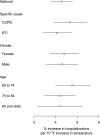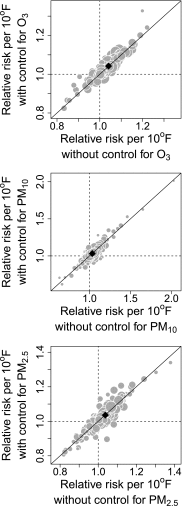Heat-related emergency hospitalizations for respiratory diseases in the Medicare population
- PMID: 23491405
- PMCID: PMC3734617
- DOI: 10.1164/rccm.201211-1969OC
Heat-related emergency hospitalizations for respiratory diseases in the Medicare population
Abstract
Rationale: The heat-related risk of hospitalization for respiratory diseases among the elderly has not been quantified in the United States on a national scale. With climate change predictions of more frequent and more intense heat waves, it is of paramount importance to quantify the health risks related to heat, especially for the most vulnerable.
Objectives: To estimate the risk of hospitalization for respiratory diseases associated with outdoor heat in the U.S. elderly.
Methods: An observational study of approximately 12.5 million Medicare beneficiaries in 213 United States counties, January 1, 1999 to December 31, 2008. We estimate a national average relative risk of hospitalization for each 10°F (5.6°C) increase in daily outdoor temperature using Bayesian hierarchical models.
Measurements and main results: We obtained daily county-level rates of Medicare emergency respiratory hospitalizations (International Classification of Diseases, Ninth Revision, 464-466, 480-487, 490-492) in 213 U.S. counties from 1999 through 2008. Overall, each 10°F increase in daily temperature was associated with a 4.3% increase in same-day emergency hospitalizations for respiratory diseases (95% posterior interval, 3.8, 4.8%). Counties' relative risks were significantly higher in counties with cooler average summer temperatures.
Conclusions: We found strong evidence of an association between outdoor heat and respiratory hospitalizations in the largest population of elderly studied to date. Given projections of increasing temperatures from climate change and the increasing global prevalence of chronic pulmonary disease, the relationship between heat and respiratory morbidity is a growing concern.
Figures




References
-
- Hajat S, Armstrong B, Baccini M, Biggeri A, Bisanti L, Russo A, Paldy A, Menne B, Kosatsky T. Impact of high temperatures on mortality: is there an added heat wave effect? Epidemiology. 2006;17:632–638. - PubMed
-
- Portier CJ, Thigpen Tart K, Carter SR, Dilworth CH, Grambsch AE, Gohlke J, Hess J, Howard SN, Luber G, Lutz JT, et al. Research Triangle Park, NC: Environmental Health Perspectives/National Institute of Environmental Health Sciences; 2010. A human health perspective on climate change: a report outlining the research needs on the human health effects of climate change.
-
- Chapman KR, Mannino DM, Soriano JB, Vermeire PA, Buist AS, Thun MJ, Connell C, Jemal A, Lee TA, Miravitlles M, et al. Epidemiology and costs of chronic obstructive pulmonary disease. Eur Respir J. 2006;27:188–207. - PubMed
-
- Astrom D, Forsberg B, Rocklov J. Heat wave impact on morbidity and mortality in the elderly population: a review of recent studies. Maturitas. 2011;69:99–105. - PubMed
Publication types
MeSH terms
Grants and funding
- P01ES018176/ES/NIEHS NIH HHS/United States
- R21 ES022585/ES/NIEHS NIH HHS/United States
- R21 ES021427/ES/NIEHS NIH HHS/United States
- K23 ES016819/ES/NIEHS NIH HHS/United States
- R01ES012054/ES/NIEHS NIH HHS/United States
- R21 ES020152/ES/NIEHS NIH HHS/United States
- R01 ES019560/ES/NIEHS NIH HHS/United States
- R21ES021427/ES/NIEHS NIH HHS/United States
- R01ES015028/ES/NIEHS NIH HHS/United States
- R01 ES012054/ES/NIEHS NIH HHS/United States
- R21ES020152/ES/NIEHS NIH HHS/United States
- K23ES016819/ES/NIEHS NIH HHS/United States
- R01ES019560/ES/NIEHS NIH HHS/United States
- R01 ES015028/ES/NIEHS NIH HHS/United States
- P01 ES018176/ES/NIEHS NIH HHS/United States
LinkOut - more resources
Full Text Sources
Other Literature Sources
Medical

